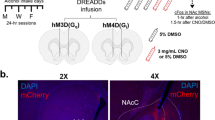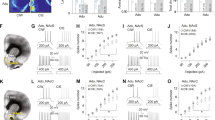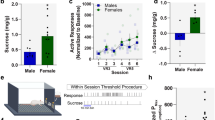Abstract
Recent studies have implicated the ethanol metabolite, acetic acid, as neuroactive, perhaps even more so than ethanol itself. In this study, we investigated sex-specific metabolism of ethanol (1, 2, and 4 g/kg) to acetic acid in vivo to guide electrophysiology experiments in the accumbens shell (NAcSh), a key node in the mammalian reward circuit. There was a sex-dependent difference in serum acetate production, quantified via ion chromatography only at the lowest dose of ethanol (males > females). Ex vivo electrophysiology recordings of NAcSh medium spiny neurons (MSN) in brain slices demonstrated that physiological concentrations of acetic acid (2 mM and 4 mM) increased NAcSh MSN excitability in both sexes. N-methyl-D-aspartate receptor (NMDAR) antagonists, AP5 and memantine, robustly attenuated the acetic acid-induced increase in excitability. Acetic acid-induced NMDAR-dependent inward currents were greater in females compared to males and were not estrous cycle dependent. These findings suggest a novel NMDAR-dependent mechanism by which the ethanol metabolite, acetic acid, may influence neurophysiological effects in a key reward circuit in the brain from ethanol consumption. Furthermore, these findings also highlight a specific sex-dependent sensitivity in females to acetic acid-NMDAR interactions. This may underlie their more rapid advancement to alcohol use disorder and increased risk of alcohol related neurodegeneration compared to males.
This is a preview of subscription content, access via your institution
Access options
Subscribe to this journal
Receive 13 print issues and online access
$259.00 per year
only $19.92 per issue
Buy this article
- Purchase on Springer Link
- Instant access to full article PDF
Prices may be subject to local taxes which are calculated during checkout




Similar content being viewed by others
References
Cederbaum AI. Alcohol metabolism. Clin Liver Dis. 2012;16:667–85.
Chapp AD, Gui L, Huber MJ, Liu J, Larson RA, Zhu J, et al. Sympathoexcitation and pressor responses induced by ethanol in the central nucleus of amygdala involves activation of NMDA receptors in rats. Am J Physiol Heart Circ Physiol. 2014;307:H701–9.
Jin S, Cao Q, Yang F, Zhu H, Xu S, Chen Q, et al. Brain ethanol metabolism by astrocytic ALDH2 drives the behavioural effects of ethanol intoxication. Nat Metab. 2021;3:337–51.
Chapp AD, Huber MJ, Driscoll KM, Behnke JE, Larson RA, Shan Z, et al. Local metabolism of ethanol to acetic acid/acetate in the central nucleus of amygdala elicits sympathoexcitatory responses through activation of NMDAR in Sprague Dawley Rats. bioRxiv. 2021:2020.07.20.212597.
Pardo M, Betz AJ, San Miguel N, López-Cruz L, Salamone JD, Correa M. Acetate as an active metabolite of ethanol: studies of locomotion, loss of righting reflex, and anxiety in rodents. Front Behav Neurosci. 2013;7:81.
Chapp AD, Mermelstein PG, Thomas MJ. The ethanol metabolite acetic acid activates mouse nucleus accumbens shell medium spiny neurons. J Neurophysiol. 2021;125:620–7.
Chapp AD, Collins AR, Driscoll KM, Behnke JE, Shan Z, Zhang L, et al. Ethanol metabolite, acetate, increases excitability of the central nucleus of amygdala neurons through activation of NMDA receptors. ACS Chem Neurosci. 2023;14:1278–90.
Mews P, Egervari G, Nativio R, Sidoli S, Donahue G, Lombroso SI, et al. Alcohol metabolism contributes to brain histone acetylation. Nature. 2019;574:717–21.
Erol A, Karpyak VM. Sex and gender-related differences in alcohol use and its consequences: contemporary knowledge and future research considerations. Drug Alcohol Depend. 2015;156:1–13.
White AM. Gender differences in the epidemiology of alcohol use and related harms in the United States. Alcohol Res. 2020;40:01.
Schwabe L, Nader K, Wolf OT, Beaudry T, Pruessner JC. Neural signature of reconsolidation impairments by propranolol in humans. Biol Psychiatry. 2012;71:380–6.
Chapp AD, Schum S, Behnke JE, Hahka T, Huber MJ, Jiang E, et al. Measurement of cations, anions, and acetate in serum, urine, cerebrospinal fluid, and tissue by ion chromatography. Physiol Rep. 2018;6:e13666.
Chapp AD, Behnke JE, Driscoll KM, Fan Y, Hoban E, Shan Z, et al. Acetate mediates alcohol excitotoxicity in dopaminergic-like PC12 cells. ACS Chem Neurosci. 2019;10:235–45.
Chen Y-H, Wu M-L, Fu W-M. Regulation of presynaptic NMDA responses by external and intracellular pH changes at developing neuromuscular synapses. J Neurosci. 1998;18:2982–90.
Frost G, Sleeth ML, Sahuri-Arisoylu M, Lizarbe B, Cerdan S, Brody L, et al. The short-chain fatty acid acetate reduces appetite via a central homeostatic mechanism. Nat Commun. 2014;5:3611.
Perry RJ, Peng L, Barry NA, Cline GW, Zhang D, Cardone RL, et al. Acetate mediates a microbiome-brain-β-cell axis to promote metabolic syndrome. Nature. 2016;534:213–7.
Klawonn AM, Malenka RC. Nucleus accumbens modulation in reward and aversion. Cold Spring Harb Symp Quant Biol. 2018;83:119–29.
Jedynak J, Hearing M, Ingebretson A, Ebner SR, Kelly M, Fischer RA, et al. Cocaine and amphetamine induce overlapping but distinct patterns of AMPAR plasticity in nucleus accumbens medium spiny neurons. Neuropsychopharmacology. 2016;41:464–76.
Di Chiara G. Nucleus accumbens shell and core dopamine: differential role in behavior and addiction. Behav Brain Res. 2002;137:75–114.
Pontieri FE, Tanda G, Di Chiara G. Intravenous cocaine, morphine, and amphetamine preferentially increase extracellular dopamine in the “shell” as compared with the “core” of the rat nucleus accumbens. Proc Natl Acad Sci USA. 1995;92:12304–8.
Engleman EA, Ding ZM, Oster SM, Toalston JE, Bell RL, Murphy JM, et al. Ethanol is self-administered into the nucleus accumbens shell, but not the core: evidence of genetic sensitivity. Alcohol Clin Exp Res. 2009;33:2162–71.
Ting JT, Daigle TL, Chen Q, Feng G. Acute brain slice methods for adult and aging animals: application of targeted patch clamp analysis and optogenetics. Methods Mol Biol. 2014;1183:221–42.
Chapp AD, Wang R, Cheng ZJ, Shan Z, Chen QH. Long-term high salt intake involves reduced SK currents and increased excitability of PVN neurons with projections to the rostral ventrolateral medulla in rats. Neural Plast. 2017;2017:7282834.
Eisinger KRT, Chapp AD, Swanson SP, Tam D, Lopresti NM, Larson EB, et al. Caveolin-1 regulates medium spiny neuron structural and functional plasticity. Psychopharmacology. 2020;237:2673–84.
Larson RA, Chapp AD, Gui L, Huber MJ, Cheng ZJ, Shan Z, et al. High salt intake augments excitability of PVN neurons in rats: role of the endoplasmic reticulum Ca2+ store. Front Neurosci. 2017;11:182.
Chen QH, Toney GM. Excitability of paraventricular nucleus neurones that project to the rostral ventrolateral medulla is regulated by small-conductance Ca2+-activated K+ channels. J Physiol. 2009;587:4235–47.
Alonso-Caraballo Y, Ferrario CR. Effects of the estrous cycle and ovarian hormones on cue-triggered motivation and intrinsic excitability of medium spiny neurons in the Nucleus Accumbens core of female rats. Horm Behav. 2019;116:104583–83.
Kourrich S, Klug JR, Mayford M, Thomas MJ. AMPAR-independent effect of striatal αCaMKII promotes the sensitization of cocaine reward. J Neurosci. 2012;32:6578–86.
Kourrich S, Thomas MJ. Similar neurons, opposite adaptations: psychostimulant experience differentially alters firing properties in accumbens core versus shell. J Neurosci. 2009;29:12275–83.
Martin G, Ahmed SH, Blank T, Spiess J, Koob GF, Siggins GR. Chronic morphine treatment alters NMDA receptor-mediated synaptic transmission in the nucleus accumbens. J Neurosci. 1999;19:9081–9.
Baraona E, Abittan CS, Dohmen K, Moretti M, Pozzato G, Chayes ZW, et al. Gender differences in pharmacokinetics of alcohol. Alcohol Clin Exp Res. 2001;25:502–7.
Chrostek L, Jelski W, Szmitkowski M, Puchalski Z. Gender-related differences in hepatic activity of alcohol dehydrogenase isoenzymes and aldehyde dehydrogenase in humans. J Clin Lab Anal. 2003;17:93–6.
Rae C, Fekete AD, Kashem MA, Nasrallah FA, Bröer S. Metabolism, compartmentation, transport and production of acetate in the cortical brain tissue slice. Neurochem Res. 2012;37:2541–53.
Lovinger DM, White G, Weight FF. Ethanol inhibits NMDA-activated ion current in hippocampal neurons. Science. 1989;243:1721–4.
Hicklin TR, Wu PH, Radcliffe RA, Freund RK, Goebel-Goody SM, Correa PR, et al. Alcohol inhibition of the NMDA receptor function, long-term potentiation, and fear learning requires striatal-enriched protein tyrosine phosphatase. Proc Natl Acad Sci. 2011;108:6650–5.
Mulholland PJ, Carpenter-Hyland EP, Woodward JJ, Chandler LJ. Ethanol disrupts NMDA receptor and astroglial EAAT2 modulation of Kv2.1 potassium channels in hippocampus. Alcohol. 2009;43:45–50.
Jiang L, Gulanski BI, De Feyter HM, Weinzimer SA, Pittman B, Guidone E, et al. Increased brain uptake and oxidation of acetate in heavy drinkers. J Clin Invest. 2013;123:1605–14.
Harmata GIS, Chan AC, Merfeld MJ, Taugher-Hebl RJ, Harijan AK, Hardie JB, et al. Intoxicating effects of alcohol depend on acid-sensing ion channels. Neuropsychopharmacology. 48, 806–815 (2023).
Shteinikov VY, Tikhonova TB, Korkosh VS, Tikhonov DB. Potentiation and block of ASIC1a by memantine. Cell Mol Neurobiol. 2018;38:869–81.
Xia P, Chen HS, Zhang D, Lipton SA. Memantine preferentially blocks extrasynaptic over synaptic NMDA receptor currents in hippocampal autapses. J Neurosci. 2010;30:11246–50.
Ho¨nack D, Lo¨scher W. Sex differences in NMDA receptor mediated responses in rats. Brain Res. 1993;620:167–70.
Woolley CS, McEwen BS. Estradiol regulates hippocampal dendritic spine density via an N-methyl-D-aspartate receptor-dependent mechanism. J Neurosci. 1994;14:7680–7.
Uhl M, Schmeisser MJ, Schumann S. The sexual dimorphic synapse: from spine density to molecular composition. Front Mol Neurosci. 2022;15:818390.
McRoberts JA, Li J, Ennes HS, Mayer EA. Sex-dependent differences in the activity and modulation of N-methyl-d-aspartic acid receptors in rat dorsal root ganglia neurons. Neuroscience. 2007;148:1015–20.
Benneyworth MA, Hearing MC, Asp AJ, Madayag A, Ingebretson AE, Schmidt CE, et al. Synaptic depotentiation and mGluR5 activity in the nucleus accumbens drive cocaine-primed reinstatement of place preference. J Neurosci. 2019;39:4785–96.
Hearing MC, Jedynak J, Ebner SR, Ingebretson A, Asp AJ, Fischer RA, et al. Reversal of morphine-induced cell-type-specific synaptic plasticity in the nucleus accumbens shell blocks reinstatement. Proc Natl Acad Sci USA. 2016;113:757–62.
Kourrich S, Rothwell PE, Klug JR, Thomas MJ. Cocaine experience controls bidirectional synaptic plasticity in the nucleus accumbens. J Neurosci. 2007;27:7921–8.
Rowlands BD, Klugmann M, Rae CD. Acetate metabolism does not reflect astrocytic activity, contributes directly to GABA synthesis, and is increased by silent information regulator 1 activation. J Neurochem. 2017;140:903–18.
Agabio R, Pisanu C, Gessa GL, Franconi F. Sex differences in alcohol use disorder. Curr Med Chem. 2017;24:2661–70.
Alfonso-Loeches S, Pascual M, Guerri C. Gender differences in alcohol-induced neurotoxicity and brain damage. Toxicology. 2013;311:27–34.
Hoffman PL, Rabe CS, Grant KA, Valverius P, Hudspith M, Tabakoff B. Ethanol and the NMDA receptor. Alcohol. 1990;7:229–31.
Lovinger DM. Excitotoxicity and alcohol-related brain damage. Alcohol Clin Exp Res. 1993;17:19–27.
Zhou X, Hollern D, Liao J, Andrechek E, Wang H. NMDA receptor-mediated excitotoxicity depends on the coactivation of synaptic and extrasynaptic receptors. Cell Death Dis. 2013;4:e560–e60.
Maxwell CR, Spangenberg RJ, Hoek JB, Silberstein SD, Oshinsky ML. Acetate causes alcohol hangover headache in rats. PLoS One. 2010;5:e15963.
Bisaga A, Comer SD, Ward AS, Popik P, Kleber HD, Fischman MW. The NMDA antagonist memantine attenuates the expression of opioid physical dependence in humans. Psychopharmacology (Berl). 2001;157:1–10.
Krishnan-Sarin S, O’Malley SS, Franco N, Cavallo DA, Morean M, Shi J, et al. N-methyl-D-aspartate receptor antagonism has differential effects on alcohol craving and drinking in heavy drinkers. Alcohol Clin Exp Res. 2015;39:300–7.
Grigsby KB, Mangieri RA, Roberts AJ, Lopez MF, Firsick EJ, Townsley KG, et al. Preclinical and clinical evidence for suppression of alcohol intake by apremilast. J Clin Invest. 2023;133:e159103.
Acknowledgements
We would like to thank Chau-Mi H. Phan and Pramit J. Jagtap for their assistance. We would also like to thank Dr. Manuel Esguerra, Dr. Timothy W. Chapp, Dr. Scott M. Chapp, Casey L. Mallo and Dr. Qing-Hui Chen for their proofreading and suggestions.
Funding
This study was supported by NIH R01DA041808 (MJT and PGM), T32DA007234 (ADC) and an MnDRIVE fellowship (ADC).
Author information
Authors and Affiliations
Contributions
ADC and CAN performed experiments; ADC and CAN, analyzed data; ADC, CAN, PGM and MJT, prepared figures; ADC, CAN, ARC, PGM and MJT drafted manuscript; ADC, CAN, ARC, PGM and MJT interpreted results of experiment; ADC, CAN, ARC, PGM and MJT edited and revised manuscript.
Corresponding authors
Ethics declarations
Competing interests
The authors declare no competing interests.
Additional information
Publisher’s note Springer Nature remains neutral with regard to jurisdictional claims in published maps and institutional affiliations.
Supplementary information
Rights and permissions
Springer Nature or its licensor (e.g. a society or other partner) holds exclusive rights to this article under a publishing agreement with the author(s) or other rightsholder(s); author self-archiving of the accepted manuscript version of this article is solely governed by the terms of such publishing agreement and applicable law.
About this article
Cite this article
Chapp, A.D., Nwakama, C.A., Collins, A.R. et al. Physiological acetic acid concentrations from ethanol metabolism stimulate accumbens shell medium spiny neurons via NMDAR activation in a sex-dependent manner. Neuropsychopharmacol. 49, 885–892 (2024). https://doi.org/10.1038/s41386-023-01752-8
Received:
Revised:
Accepted:
Published:
Issue Date:
DOI: https://doi.org/10.1038/s41386-023-01752-8



